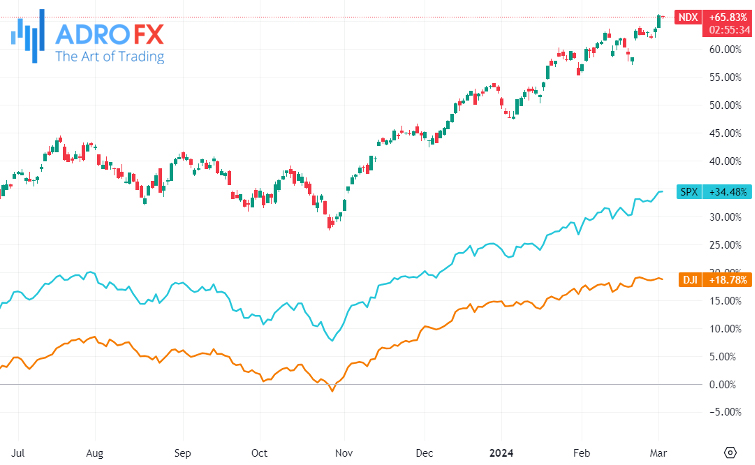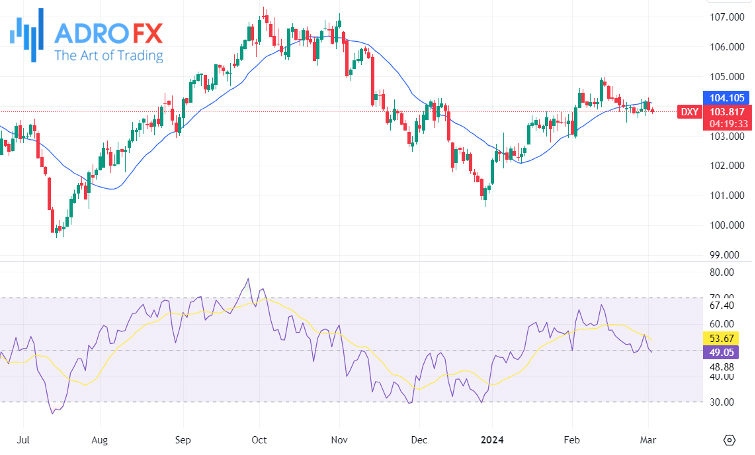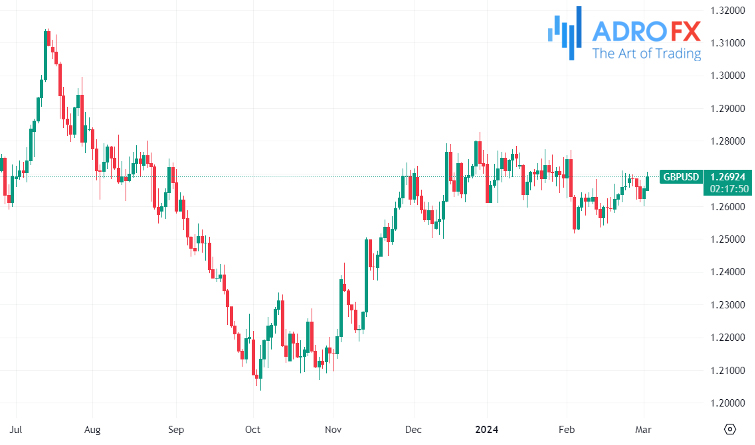US Stocks Retreat, Apple Faces Antitrust Fine, and DXY's Technical Complexities Unveiled | Daily Market Analysis

Key events:
- USA - S&P Global Services PMI (Feb)
- USA - ISM Non-Manufacturing PMI (Feb)
- USA - ISM Non-Manufacturing Prices (Feb)
On Monday, US stock markets experienced a retreat from recent record highs, with Federal Reserve officials downplaying the possibility of imminent rate cuts ahead of key economic data and anticipated testimony from Fed Chair Jerome Powell later in the week. The S&P 500, a benchmark index, slipped by 0.1%, the Nasdaq Composite, known for its tech-heavy composition, fell by 0.2%, and the Dow Jones Industrial Average, consisting of blue-chip stocks, saw a loss of 92 points, equivalent to 0.2%.

Apple faced a significant setback as it received a €1.84 billion antitrust fine from the European Commission. The fine alleges that Apple hindered competition from rival music streaming services like Spotify by imposing restrictions on its App Store. Although Apple plans to appeal, its shares experienced a 3% decline, contributing to a broader weakness in the tech sector. However, a surge in semiconductor stocks, notably a 25% rise in Super Micro Computer Inc, which is set to join the S&P 500 on March 18, helped offset losses.

The US Dollar Index is currently fluctuating around 103.70, showing slight losses on Monday. Market attention remains focused on potential shifts in response to incoming data, including the eagerly awaited Nonfarm Payrolls figures for February scheduled for release later in the week. The US labor market's performance continues to influence the anticipated easing cycle by the Federal Reserve, expected to commence in June. A potential slowdown in employment could lead to a more dovish stance by the Fed, signifying lower interest rates and possible near-term cuts, which might weaken the US Dollar.
From a technical perspective, the DXY presents a somewhat complex scenario.

The Relative Strength Index indicates a negative stance with a descending trajectory, suggesting an overall bearish momentum in the short term. Similarly, the Moving Average Convergence Divergence (MACD) exhibits an increase in red bars, supporting the notion of growing selling momentum and reinforcing the bearish outlook. However, the Simple Moving Averages (SMAs) provide a different perspective on a broader scale. Despite the DXY slipping below the 20 and 100-day SMAs, it remains notably above the 200-day SMA. This resilient position suggests that the bulls maintain control over the larger time horizon. Consequently, while the immediate outlook may favor the bears, the persistent bullish undertone cannot be dismissed.
Canadian Dollar is traversing familiar territory as markets eagerly await the Bank of Canada's rate announcement and the upcoming US Nonfarm Payrolls report scheduled for Friday. Anticipated to maintain rates at 5% on Wednesday, the BoC's decision will be closely monitored, while investors eyeing a potential rate cut from the Federal Reserve will scrutinize US economic indicators for signs of softening throughout the week.

This week's focal points in Canadian data include the BoC's rate decision, overshadowing Friday's Canadian labor figures by the impending release of the US NFP employment data. Expectations suggest a slight increase in Canada's Unemployment Rate, with market forecasts indicating a potential decline in the US NFP figures.
In Monday's trading session, EUR/USD ventured into higher levels, initiating the week around 1.0860 and encountering resistance near-term on the charts.

The Pound Sterling maintains its position with gains, trading around 1.2670 on Monday. Investors are pricing in the likelihood that the Bank of England will refrain from lowering interest rates in the near future. The UK continues to exhibit the highest inflation rate among the Group of Seven economies (G-7), compelling BoE policymakers to sustain interest rates in restrictive territory for an extended duration.

The UK's robust wage growth, particularly influential in driving inflation in the services sector, has resulted in the persistent elevation of the core Consumer Price Index. BoE policymakers emphasize that the growth pace of labor costs and service inflation surpasses the necessary rate for inflation to consistently return to the 2% target.
The Pound Sterling stands to benefit from the prospect of higher interest rates, attracting increased foreign inflows. This week, with a relatively light UK economic calendar, market sentiment is poised to play a significant role in guiding the GBP/USD pair.









